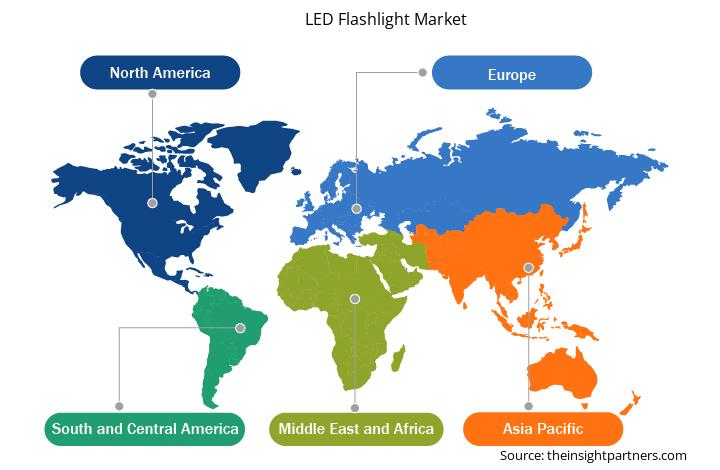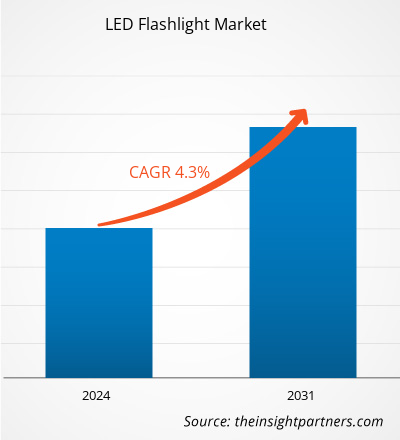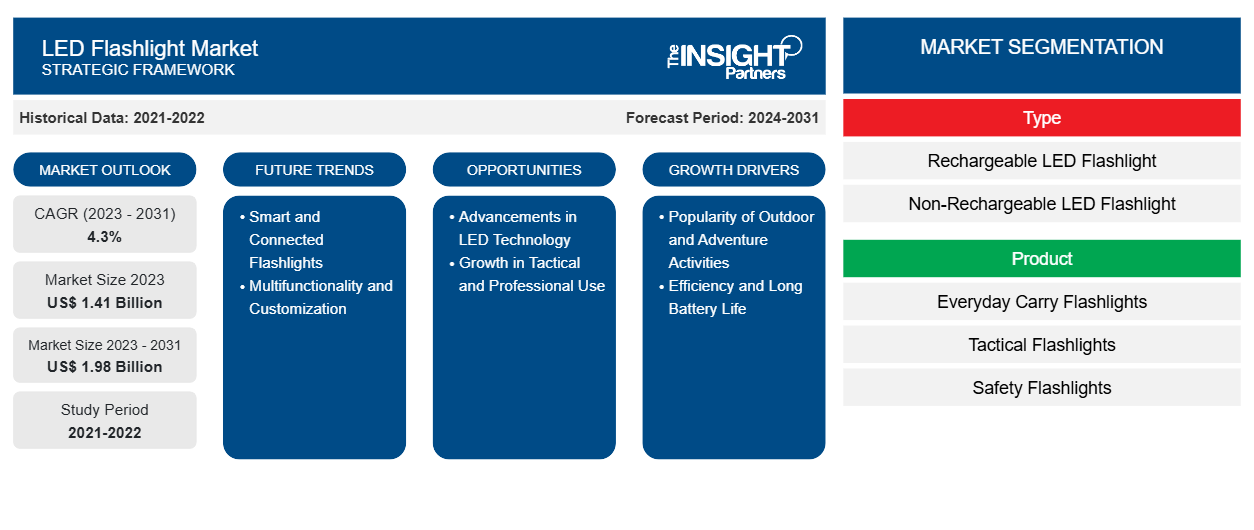Si prevede che il mercato delle torce a LED raggiungerà 1,98 miliardi di dollari entro il 2031, rispetto agli 1,41 miliardi di dollari del 2023. Si stima che il mercato registrerà un CAGR del 4,3% nel periodo 2023-2031. La crescente domanda di torce intelligenti e connesse porterà probabilmente nuove tendenze nel mercato nei prossimi anni.
Analisi di mercato delle torce a LED
La crescente popolarità delle attività all'aperto e di avventura e l'efficienza e la lunga durata della batteria delle torce a LED stanno guidando la crescita del mercato delle torce a LED . Poiché sempre più persone partecipano ad attività all'aperto come campeggio, escursionismo e caccia, c'è una crescente necessità di illuminazione affidabile e portatile. Inoltre, le torce a LED sono altamente efficienti dal punto di vista energetico, utilizzano meno energia e hanno una durata della batteria più lunga rispetto alle normali luci a incandescenza o alogene. Inoltre, si prevede che i progressi nella tecnologia LED e la crescita nell'uso tattico e professionale creeranno opportunità redditizie per la crescita del mercato delle torce a LED. Si prevede che le torce intelligenti e connesse e la multifunzionalità e personalizzazione delle torce a LED porteranno nuove tendenze nel mercato delle torce a LED.
Panoramica del mercato delle torce a LED
Le torce a LED sono tecnologicamente avanzate e possono soddisfare molto più delle semplici esigenze domestiche di base. Sono più luminose, più efficienti e più affidabili delle torce standard. Le torce a LED sono utilizzate per una varietà di scopi, tra cui scenari di emergenza, attività all'aperto come campeggio ed escursionismo, operazioni militari e delle forze dell'ordine, ispezioni industriali e trasporto personale quotidiano. Sono fondamentali per la sicurezza domestica, la manutenzione delle auto, la fotografia, gli esami medici e la ricerca scientifica. La loro elevata efficienza energetica, la longevità e la luce intensa e concentrata le rendono indispensabili in una varietà di applicazioni. Il mercato delle torce a LED trae vantaggio anche dal passaggio a prodotti sostenibili, poiché le torce a LED sono più efficienti dal punto di vista energetico e durano più a lungo delle tradizionali luci a incandescenza o fluorescenti .
Personalizza questo report in base alle tue esigenze
Riceverai la personalizzazione gratuita di qualsiasi report, comprese parti di questo report, o analisi a livello nazionale, pacchetto dati Excel, oltre a usufruire di grandi offerte e sconti per start-up e università
-
Scopri le principali tendenze di mercato in questo rapporto.Questo campione GRATUITO includerà analisi di dati che spaziano dalle tendenze di mercato alle stime e alle previsioni.
Driver e opportunità del mercato delle torce a LED
Efficienza e lunga durata della batteria
Le torce a LED sono altamente efficienti dal punto di vista energetico; consumano meno energia e hanno una durata della batteria più lunga rispetto alle normali luci a incandescenza o alogene. Le torce a LED consumano meno energia per produrre la stessa luce o addirittura di più, il che le rende la scelta preferita per le torce. Ciò è particolarmente importante per gli utenti che si affidano alle torce per attività all'aperto, emergenze o uso professionale, dove è essenziale massimizzare la durata della batteria. Le torce a LED stanno diventando sempre più popolari poiché consumatori e aziende apprezzano la sostenibilità e le soluzioni convenienti grazie ai loro costi operativi inferiori e al minore impatto ambientale. Vari attori in tutto il mondo offrono torce a LED efficienti e con una lunga durata della batteria. Ad esempio, la Community di Anker offre la Bolder LC90 di Anker, una torcia a LED ad alta efficienza e basso costo progettata per l'uso quotidiano. Ha una durata della batteria fino a 6 ore ad alta luminosità (900 lumen) e può essere ricaricata tramite USB-C, una caratteristica comoda per gli utenti attuali. Inoltre, la Fenix PD36R è una torcia LED ricaricabile popolare tra gli amanti dell'outdoor, gli escursionisti e i campeggiatori. È alimentata da una batteria ricaricabile agli ioni di litio 21700, che può durare fino a 115 ore con l'impostazione di luminosità più bassa e 1,5 ore con l'impostazione più alta (1600 lumen). La lunga durata della batteria è fondamentale all'aperto e nelle emergenze, dove l'accesso alle fonti di alimentazione è limitato. Una torcia, come la Fenix PD36R, consente agli utenti di fare affidamento su un singolo dispositivo per lunghi periodi, rendendola perfetta per spedizioni di più giorni o scenari di emergenza che richiedono un'illuminazione costante e affidabile. Pertanto, l'efficienza e la lunga durata della batteria delle torce LED stanno guidando la crescita del mercato.
Crescita nell'uso tattico e professionale
Si prevede che la domanda di torce professionali e tattiche aumenterà in settori quali forze dell'ordine, militari , marina, ricerca e soccorso e vigili del fuoco. Questi settori necessitano di torce ad alte prestazioni, di lunga durata e multifunzionali con caratteristiche quali elevata luminosità, impermeabilità e durata prolungata della batteria. I produttori hanno la possibilità di creare torce speciali che soddisfino le esigenze di questi professionisti. L'esercito preferisce faretti tattici che possono essere posizionati su un'arma o un'armatura. Le torce militari devono essere installate per consentire l'uso a mani libere, poiché le armi trasportate richiedono entrambe le mani. Vari attori offrono torce a LED per uso tattico e professionale. Ad esempio, la torcia Streamlight ProTac HL-X fornisce fino a 1.000 lumen di luminosità. Utilizza LED per estendere la durata della batteria, il che è fondamentale per le forze dell'ordine e il personale militare.
Il personale della Marina raccomanda di usare una torcia elettrica così luminosa da poter disinnescare situazioni di tensione. Usare una torcia elettrica ad alta luminosità può impedire agli spettatori di identificare e valutare la persona che porta la luce. Impedire la linea di vista in uno scontro con armi è una strategia potente che può essere usata sia in ambito civile che militare. Inoltre, in caso di emergenza, una torcia elettrica tattica può salvare vite. La luce intensa può essere usata per segnalare la richiesta di assistenza da una lunga distanza. Se ci si perde nei boschi o si rimane bloccati sul ciglio della strada, una torcia elettrica tattica con modalità stroboscopica o SOS può aiutare i soccorritori a trovarne uno più velocemente. Alcuni modelli contengono persino lenti o filtri colorati che possono essere usati per indicare determinate forme di disagio. Pertanto, si prevede che il crescente uso tattico e professionale delle torce elettriche a LED offrirà significative potenziali opportunità per il mercato.
Analisi della segmentazione del rapporto di mercato delle torce a LED
I segmenti chiave che hanno contribuito alla derivazione dell'analisi di mercato delle torce a LED sono tipologia, prodotto e applicazione.
- In base al tipo, il mercato è segmentato in torcia LED ricaricabile e torcia LED non ricaricabile. Il segmento della torcia LED ricaricabile ha dominato il mercato nel 2023.
- In base al prodotto, il mercato è segmentato in torcia di sicurezza, torcia da trasporto quotidiano e torcia tattica. Il segmento della torcia da trasporto quotidiano ha dominato il mercato nel 2023.
- In termini di applicazione, il mercato delle torce LED è suddiviso in residenziale, commerciale, militare e forze dell'ordine. Il segmento residenziale ha dominato il mercato nel 2023.
Analisi della quota di mercato delle torce a LED per area geografica
- Il mercato delle torce a LED è suddiviso in cinque regioni principali: Nord America, Europa, Asia Pacifico (APAC), Medio Oriente e Africa (MEA) e Sud e Centro America.
- L'Asia Pacifica ha dominato il mercato delle torce LED, seguita da Europa e Nord America. La rapida urbanizzazione in Cina, India e Indonesia ha aumentato la domanda di soluzioni di illuminazione compatte, durature ed efficienti dal punto di vista energetico. Nelle città, le torce LED sono utilizzate non solo per la preparazione alle emergenze, ma anche per le attività notturne, come il pendolarismo e la sicurezza personale. I produttori cinesi stanno sviluppando nuove tecnologie LED che offrono un flusso luminoso più elevato, una maggiore durata della batteria e una maggiore resistenza. I rapidi progressi nella tecnologia LED hanno portato allo sviluppo di torce più efficienti, affidabili e convenienti che attraggono un'ampia gamma di consumatori. Aziende cinesi come Xiaomi e Olight hanno introdotto torce LED intelligenti con caratteristiche come luminosità regolabile, ricarica USB e opzioni di alimentazione solare. Inoltre, diversi attori del mercato stanno collaborando per sviluppare torce LED avanzate. Ad esempio, in collaborazione con Cree, IMALENT ha portato un nuovo livello di luminosità ed efficienza nel campo delle torce. IMALENT e Cree LED hanno innegabilmente rivoluzionato il campo delle torce elettriche con la loro tecnologia all'avanguardia e le innovazioni rivoluzionarie. La loro collaborazione ha introdotto una nuova era di soluzioni di illuminazione super luminose e affidabili che soddisfano un'ampia gamma di applicazioni, tra cui avventure all'aria aperta, preparazione alle emergenze o uso professionale.
Approfondimenti regionali sul mercato delle torce a LED
Le tendenze regionali e i fattori che influenzano il mercato delle torce a LED durante il periodo di previsione sono stati ampiamente spiegati dagli analisti di Insight Partners. Questa sezione discute anche i segmenti e la geografia del mercato delle torce a LED in Nord America, Europa, Asia Pacifico, Medio Oriente e Africa e America meridionale e centrale.

- Ottieni i dati specifici regionali per il mercato delle torce a LED
Ambito del rapporto sul mercato delle torce a LED
| Attributo del report | Dettagli |
|---|---|
| Dimensioni del mercato nel 2023 | 1,41 miliardi di dollari USA |
| Dimensioni del mercato entro il 2031 | 1,98 miliardi di dollari USA |
| CAGR globale (2023-2031) | 4,3% |
| Dati storici | 2021-2022 |
| Periodo di previsione | 2024-2031 |
| Segmenti coperti |
Per tipo
|
| Regioni e Paesi coperti |
America del Nord
|
| Leader di mercato e profili aziendali chiave |
|
Densità dei player del mercato delle torce a LED: comprendere il suo impatto sulle dinamiche aziendali
Il mercato delle torce a LED sta crescendo rapidamente, spinto dalla crescente domanda degli utenti finali dovuta a fattori quali l'evoluzione delle preferenze dei consumatori, i progressi tecnologici e una maggiore consapevolezza dei vantaggi del prodotto. Con l'aumento della domanda, le aziende stanno ampliando le loro offerte, innovando per soddisfare le esigenze dei consumatori e capitalizzando sulle tendenze emergenti, il che alimenta ulteriormente la crescita del mercato.
La densità degli operatori di mercato si riferisce alla distribuzione di aziende o società che operano in un particolare mercato o settore. Indica quanti concorrenti (operatori di mercato) sono presenti in un dato spazio di mercato in relazione alle sue dimensioni o al valore di mercato totale.
Le principali aziende che operano nel mercato delle torce a LED sono:
- Prodotti Bayco Inc.
- Prodotti della costa
- Duracell Inc
- Doratura
- Azienda: Ledlenser GmbH & Co. KG
- Società a responsabilità limitata Dorcy International, Inc.
Disclaimer : le aziende elencate sopra non sono classificate secondo un ordine particolare.

- Ottieni una panoramica dei principali attori del mercato delle torce a LED
Notizie e sviluppi recenti sul mercato delle torce a LED
Il mercato delle torce a LED viene valutato raccogliendo dati qualitativi e quantitativi dopo la ricerca primaria e secondaria, che include importanti pubblicazioni aziendali, dati di associazioni e database. Di seguito sono elencati alcuni degli sviluppi nel mercato delle torce a LED:
- COAST, leader mondiale nella tecnologia di illuminazione portatile a LED e nei coltelli, ha lanciato la torcia tascabile SLAYER l'anno scorso con recensioni eccezionali. Una torcia portatile elegante e sottile, perfetta per l'uso quotidiano, ora ha opzioni aggiuntive di modalità luce rossa o puntatore laser per maggiore facilità e sicurezza. La serie di torce SLAYER è una struttura impermeabile e resistente alla polvere con materiali di prima qualità adatti ai lavori più duri. La forma rettangolare piatta del telaio interamente in alluminio scivola facilmente dentro e fuori dalle tasche e si fissa in modo sicuro utilizzando la clip da tasca in metallo rimovibile. È un perfetto trasporto in movimento per qualsiasi lavoro. (Fonte: COAST, comunicato stampa, mercato 2024)
- Nite Ize, produttore leader di prodotti innovativi basati su soluzioni, ha lanciato la torcia tattica ricaricabile INOVA T4R Long Throw. Disponibile al dettaglio a fine estate, la torcia montata sulla culla è dotata di un impressionante raggio di 1.000 metri per illuminare missioni critiche e condizioni estreme. "La nuova torcia INOVA T4R Long Throw è un vero trionfo dell'ingegneria", ha affermato Rick Case, fondatore e CEO di Nite Ize. "Con una portata effettiva fino a un chilometro, è pronta a essere uno strumento fondamentale per le squadre di soccorso e non solo. (Fonte: Nite Ize, comunicato stampa, giugno 2023)
Copertura e risultati del rapporto sul mercato delle torce a LED
"Dimensioni e previsioni del mercato delle torce a LED (2021-2031)" fornisce un'analisi dettagliata del mercato che copre le aree menzionate di seguito:
- Dimensioni e previsioni del mercato delle torce a LED a livello globale, regionale e nazionale per tutti i principali segmenti di mercato coperti dall'ambito
- Tendenze del mercato delle torce a LED, nonché dinamiche di mercato come driver, restrizioni e opportunità chiave
- Analisi PEST e SWOT dettagliate
- Analisi del mercato delle torce a LED che copre le principali tendenze del mercato, il quadro globale e regionale, i principali attori, le normative e i recenti sviluppi del mercato
- Analisi del panorama industriale e della concorrenza che copre la concentrazione del mercato, l'analisi della mappa di calore, i principali attori e gli sviluppi recenti per il mercato delle torce a LED
- Profili aziendali dettagliati
- Analisi storica (2 anni), anno base, previsione (7 anni) con CAGR
- Analisi PEST e SWOT
- Valore/volume delle dimensioni del mercato - Globale, Regionale, Nazionale
- Industria e panorama competitivo
- Set di dati Excel
Report recenti
Testimonianze
Motivo dell'acquisto
- Processo decisionale informato
- Comprensione delle dinamiche di mercato
- Analisi competitiva
- Analisi dei clienti
- Previsioni di mercato
- Mitigazione del rischio
- Pianificazione strategica
- Giustificazione degli investimenti
- Identificazione dei mercati emergenti
- Miglioramento delle strategie di marketing
- Aumento dell'efficienza operativa
- Allineamento alle tendenze normative























 Ottieni un campione gratuito per - Mercato delle torce a LED
Ottieni un campione gratuito per - Mercato delle torce a LED